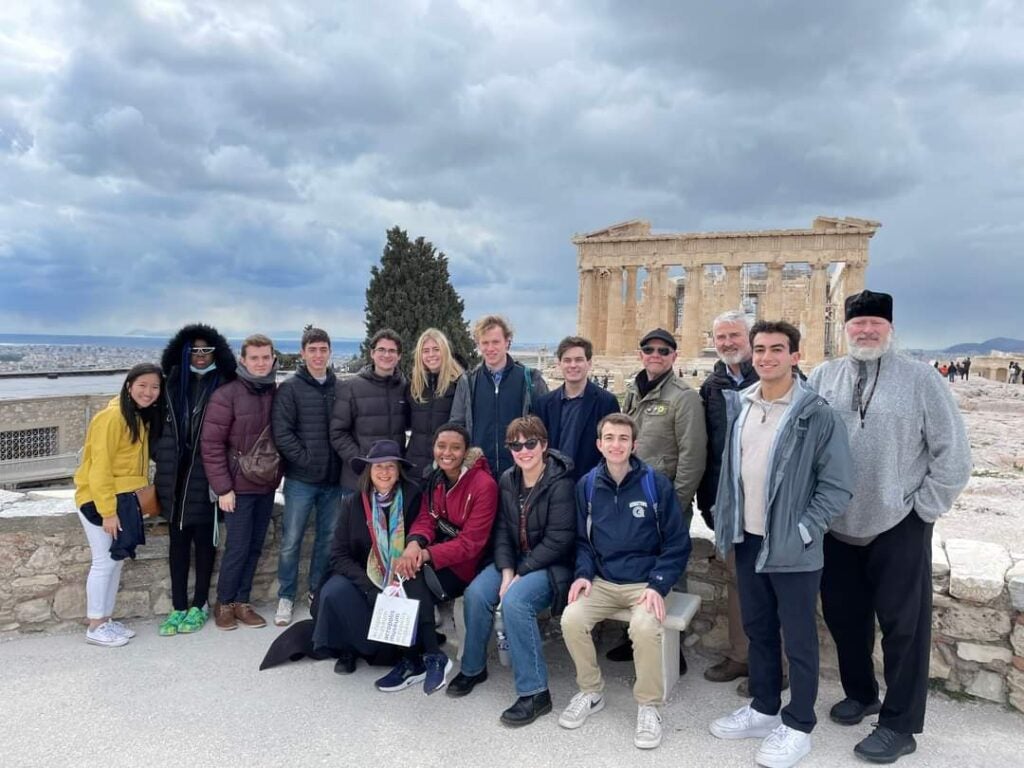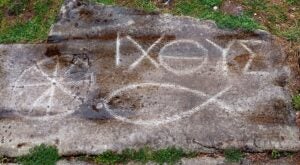In the Footsteps of St. Paul

Students and chaplains in front of the Parthenon, Temple of Athena, Athens, Greece.
Two buses, three flights, and nearly twenty-four hours later, we finally reached the first site of our pilgrimage: Thessaloniki, Greece. Weathered and tired, the fourteen other pilgrims and I settled in for the night, excited for the week to come.
In the weeks prior to this cross-continental journey, I visited two services at Georgetown — one Catholic, one Orthodox — to become better acquainted with the faiths I would be traveling alongside. As a Protestant, this was important to me. I knew very little about the other traditions on campus, and even less about my fellow pilgrims.
 That soon changed. On day two, our pilgrimage took us to the biblical city of Phillipi, the location of the first church in Europe and the subject of the Apostle Paul’s letter to the Philippians. Despite the rain, we navigated the 2000-year-old ruins of crumbling, eroded stone, making our way to the ancient city’s agora. Paul’s letter was not only shared here, but Paul himself ministered at this hub of civic and political life. This was particularly powerful, especially as we reflected on a reading from Philippians 4. Just beyond the agora, we came face-to-face with the cell where Paul was imprisoned for his ministry. Two discrete symbols of Christian faith, a fish and ictus, were etched on a concrete slab just a short walk away. Written alongside this graffiti was a Greek phrase, translated into English, which read, “Jesus Christ, Son of God,” (pictured above).
That soon changed. On day two, our pilgrimage took us to the biblical city of Phillipi, the location of the first church in Europe and the subject of the Apostle Paul’s letter to the Philippians. Despite the rain, we navigated the 2000-year-old ruins of crumbling, eroded stone, making our way to the ancient city’s agora. Paul’s letter was not only shared here, but Paul himself ministered at this hub of civic and political life. This was particularly powerful, especially as we reflected on a reading from Philippians 4. Just beyond the agora, we came face-to-face with the cell where Paul was imprisoned for his ministry. Two discrete symbols of Christian faith, a fish and ictus, were etched on a concrete slab just a short walk away. Written alongside this graffiti was a Greek phrase, translated into English, which read, “Jesus Christ, Son of God,” (pictured above).

Monastery of Varlaam, Kalabaka, Greece. Left to right: Veronica Williams (C’23), Sam Lovell (C’25), Naomi Eluojierior (C’23), and Mary Nguyen (C’25).
Not long after Phillipi did we find ourselves traversing the Meteora in Kalabaka, awing the snow-capped, hazy mountains surrounding us. Orthodox monasteries, some nearly a millennium old, dotted rock formations ascending hundreds of feet into the distant, gray sky. Inside the Monastery of Varlaam, we were greeted by ancient icons depicting martyrs, the disciples, and Jesus himself. As customary, we lit candles and silently prayed. Before leaving, some even received blessings from a resident monk.
As we reached our journey’s end in Athens, the 2500-year-old Parthenon awaited us. Although built as a Pagan temple, I was surprised to learn that the Parthenon was a Christian church for nearly 1000 years, from 500A.D. until 1450A.D. Even here, in the most unlikely of places, I discovered a setting conducive to spiritual reflection and religious pilgrimage. The Parthenon also provided a commanding panorama of Athens, serving as a satisfying yet bitter-sweet finale to our eight-day pilgrimage in Greece.
Even in the moment, these scenes were difficult to grasp. They are even more difficult to describe. At times, a collective silence and awe seized us, pilgrims. Yet, it was precisely this shared spiritual experience that bound us together, both as distinct individuals and as the faith traditions we represented. In Galatians 3:28, Paul spoke of this same unifying truth: “There is neither Jew nor Greek, there is neither slave nor free, there is no male and female, for you are all one in Christ Jesus.”
Interfaith dialogue is not simply a value of Georgetown, the Jesuits, or our Magis trip — it is a value of Paul, too. While I marveled at the monuments and ruins, I came to understand there was more to the footsteps of Paul than where he was literally present. It encompassed his spirit, his way of life.
On this Magis Immersion trip, I was able to engage with both meanings.
As a Protestant, Magis Greece gave me the opportunity to interact with two faith traditions I would not have otherwise. It gave me the opportunity to meet incredible people, including students and priests, who deepened my own sense of spirituality. Most importantly, it gave me the opportunity to seek the real work of Paul, seize it, and apply it to my own life.
For that, I am ever grateful.
“In everything give thanks.”
— 1 Thessalonians 5:18
by Sam Lovell (C’25). Sam is pursuing a degree in government and economics.